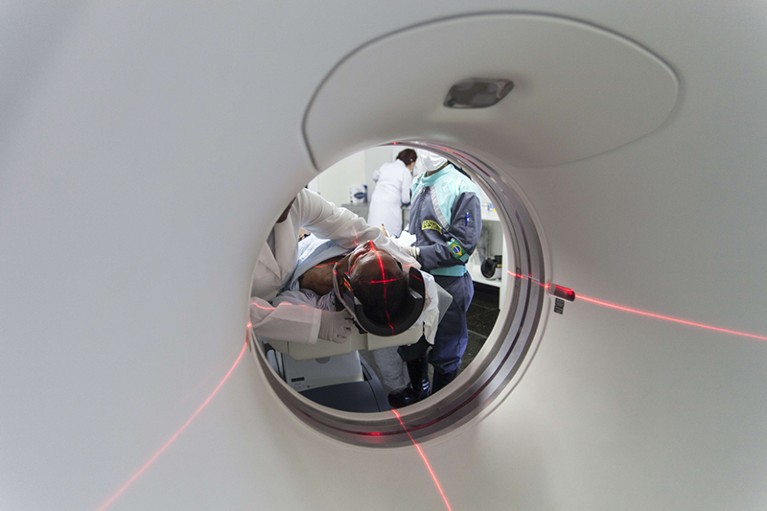
Brain imaging, including magnetic resonance scans, can provide information on psychiatric disorders.Credit: Ricardo Funari/ LightRocket via Getty
The Disordered Mind: What Unusual Brains Tell Us About Ourselves Eric R. Kandel Farrar, Straus and Giroux (2018)
In 1939, nine-year-old Eric Kandel and his family fled Nazi-occupied Vienna for the United States. Eventually entering Harvard University in Cambridge, Massachusetts, he intended to train as a psychoanalyst. But he felt that understanding mechanisms such as repression, conceived by fellow Viennese exile Sigmund Freud, demanded knowledge of their neurological underpinnings. So he turned to brain research.
Kandel’s work in the 1960s — uncovering the circuitry of learning processes by measuring neuronal activity in the marine mollusc Aplysia — earned him a Nobel prize. But his first intellectual passion never left him. Over the past 15 years or so, he has attempted to restore prestige and influence to psychoanalysis by wedding it to a “new biology of mind”. This, he argues in The Disordered Mind, is aided by three advances: brain imaging, study of how psychiatric disorders are inherited and animal models for conditions such as autism spectrum disorder (ASD).
Like Freud, he probes the unconscious. But for Kandel, these are processes of genetic development and dysfunctions of neurological circuits. Clearly and concisely, he leads us through recent findings and hypotheses on various disorders. Some are neurological, such as Alzheimer’s, Huntington’s and Parkinson’s diseases. Some have been interpreted as psychiatric, such as depression, bipolar disorder and schizophrenia. The modern perspective, he asserts, is that these are ultimately brain disorders. ‘Modern’ might be a misnomer: as long ago as 1845, German psychiatrist Wilhelm Griesinger issued the dictum Geisteskrankheiten sind Gehirnkrankheiten (mental illnesses are brain diseases). But Kandel is right about the importance of new tools — the methods, instruments and theories now available that might open promising avenues into psychiatric disorders.
The genetics of ASD and schizophrenia are a case in point. Autism is often diagnosed when a child is three or four. Schizophrenia is mostly late-onset, developing in adolescence or early adulthood. When one identical twin has autism, the chances are about 90% that the other has, too; with schizophrenia, the figure is about 50%, even for twins raised apart. However, genetic studies have pointed out that a single mutation on chromosome 7 increases the chances of developing autism and schizophrenia. Other, spontaneous, types of mutation are more frequent in the sperm of older fathers, again raising the chances of developing ASD and schizophrenia. At the genetic level, there might be a close relationship between the conditions that fails to manifest in their expression.
Kandel notes, however, that in terms of brain development, ASD and schizophrenia are polarized. From the age of two, children with autism have been found to have more synapses (the contacts between neurons) than neurotypical children. Thus, autism might be correlated with insufficient ‘pruning’ of disused connections; an excess of synapses could explain the extraordinary long-term memory of some people with ASD. By contrast, people with schizophrenia have fewer synapses than do those without, raising the possibility that excessive pruning could underlie the disorder. A shortage of connections in the prefrontal cortex could cause problems with working memory and higher cognitive functions.
Kandel explores another case in which a common genetic change might cause very different symptoms: Alzheimer’s and Parkinson’s disease. Mutations associated with Alzheimer’s might result in clumps of misfolded proteins in the brain, causing severe memory loss. Those associated with Parkinson’s could lead to the death of cells that make dopamine, the neurotransmitter vital for movement.
None of these insights has brought relief, pharmacological or otherwise. A potentially beneficial discovery, Kandel shows, is that healthy bones make osteocalcin, a hormone that stimulates proteins needed for memory formation. Studies by him and his colleagues show that age-related memory decline can be reversed when old mice are injected with osteocalcin. In humans, exercise builds bone mass, which could improve memory. (To misquote US President John F. Kennedy: “Ask not what your memory can do for you; ask what you can do for your memory.”)
Kandel’s attempt to biologize psychiatry is not for the sensitive; his focus is medication and compensating for faulty wiring, not gaining psychological insight into inner turbulence. At times, he proposes a less-than-convincing reframing: that because psychoanalysis is a learning process, which involves synaptic changes, the therapy is essentially a biological treatment. However, reading a book or watching a film will bring about synaptic changes, too — and we wouldn’t count either as primarily biological activities.
Bold propositions such as Kandel’s in The Disordered Mind blur the distinction between therapies involving medication or surgery and those that use behavioural and cognitive means. Still, one should appreciate Kandel’s humanistic aims: knowing more about disorders makes us less likely to stigmatize those who think or act differently.

 From meat to mind: the root of consciousness
From meat to mind: the root of consciousness
 Pamela Sklar: Psychiatrist who sought the genetic roots of mental illness
Pamela Sklar: Psychiatrist who sought the genetic roots of mental illness
 The risks of reading the brain
The risks of reading the brain
 The aesthetic brain
The aesthetic brain






